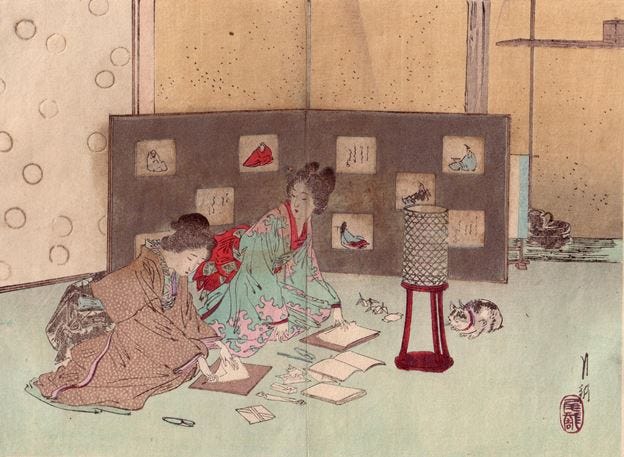Two ukiyo-e prints by Ogaka Gekko
A rare glimpse into Japanese paperfolding in private homes at the end of the 19th Century
We know surprisingly little about traditional Japanese origami. Most of what we do know comes from kindergarten text books, articles in children’s magazines, and from woodblock prints.
Ogaka Gekko (real name Nakagami Masanosuke) was born in 1859 and died in 1920. He was a prolific print designer and became well-known internationally, winning prizes at several major Expositions around the world, . Two of his prints feature origami designs, and they give us a rare glimpse into the kind of origami that was being folded in private homes in Japan in the late 19th century, a glimpse that is difficult to obtain in any other way.
This beautiful print, from 1891, shows a woman folding a traditional wrapper for a gift of flowers, but the main interest lies in the cartouche above her head.
The characters on the right hand side are the name of the series the print is part of, 'Fujin Fuzoku Zukushi’ (The Manners and Customs of Women), and those on the left read ‘Ori-mono’ (Folded things) and are the title of the print itself. (My thanks to Nobuko Okabe for these transliterations and translations.) Two Paper Cranes appear above the cartouche and two other paperfolds are partially concealed behind it. The yellow one appears to be a Hokakebune (or Boat with Sail). The mystery here is the blue design on the right hand side. What is it? It is clear that the artist intends us to be able to recognise it from the small portion he shows - but I confess I can’t. Suggestions welcome …
This second print, from 1898, doesn’t have a cartouche to tell us what it is and I am indebted to David Humphries of ogatagekko.net for the information that it is part of an album titled ‘Nihon Joreishiki’ (Etiquette for young Women).
Both women shown in the print are folding paper and a number of the designs they have already folded are scattered on the floor. Some of these are easy to recognise, others less so. From bottom left to top right they are (or appear to me to be) 1, an otherwise unknown folded packet: 2, a twisted letter: 3, possibly a packet decorated with a butterfly: 4, the Tenjin Shrine (both a design in its own right and the basic form from which the Takarabune (the Japanese version of the Chinese Junk) is developed: 5, some kind of bird?: 6, what may not be a design in it’s own right but a base of some kind?: 7: a Long Lantern and finally : 8, two Paper Cranes. There are also a pair of scissors and what looks like a pointed tool. If anyone can help identify any of these objects with more clarity please let me know.
This second print is much better known in the origami world than the first, because it appeared in 1922, in the tourist magazine 'Japan', in an article written by the American anthropologist Frederick Starr. The article was titled 'The Art of Paper Folding in Japan' and as well as including this print, explained how he was shown, and allowed to have copied, the famous Kan No Mado manuscript.
Here is Starr’s interpretation of the print, which, you may notice, differs significantly in some places from my own. I am, for instance, not convinced that the difference between the world of the print, which Starr characterises as ‘Old Japan’, and the world of 1922 were as great as he makes out.
I am indebted to Laura Rosenberg for letting me see a copy of the Starr article, which comes from the archives of the Museo del Origami in Colonia, Uruguay.









Thanks for pointing out these errors. I have corrected them in the text now.
I’ve come back several times to the mysterious folded letter/envelope in the foreground. Using John Cunliffe’s models* envelopes and letterfolds, I’ve tried to approximate it’s construction. Have you attempted it?
* https://www.make-origami.com/ELF/